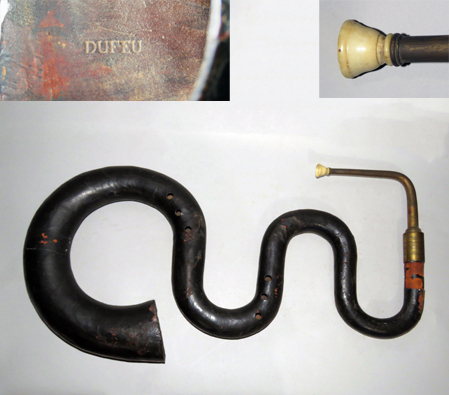
Owner: HWMC
Catalog # 2CL-AELV-65
Provenance: Received through the generous donation of “David and Debbie Caplin”
Serpents
Dufeu 'Serpent'
France
Dufeu
Wood, leather, brass, ivory
ca. 1790-1810 CE
Length: 92 in, Bell diameter: 4.5 in
Wind Instruments – Brasswinds – Serpents
Stamped two places inside the bell: DUFEU
This keyless snake-like horn was referred to as a French “Church” style Serpent and is pitched in ‘C.’ It is closely related to the cornett, which is a conical bore, cup mouthpiece, finger holed, wooden ‘brass’ instrument. The serpent is also known as an ancestor to the ophicleide and tuba. This serpent is made of wood bound with leather, and a brass crook with its original ivory mouthpiece. Because the sound originates with the vibration of the player’s lips in a cup mouthpiece, the serpent is classified as a brass instrument.
The serpent was used to support and accompany the low male voice in plainsong chants beginning in the late sixteenth century in France and later in the English church bands during the eighteenth and nineteenth centuries. During the mid-eighteenth century it became a popular instrument in the English and German military bands. It was also used in the orchestra as a bass voice by such composers as Handel, Haydn, Berlioz, and Mendelsohn.
Resource: “The New Langwill Index: A Dictionary of Musical Wind-Instrument Makers and Inventors”, 1993. William Waterhouse. Publisher: Tony Bingham, London, pg. 97.
